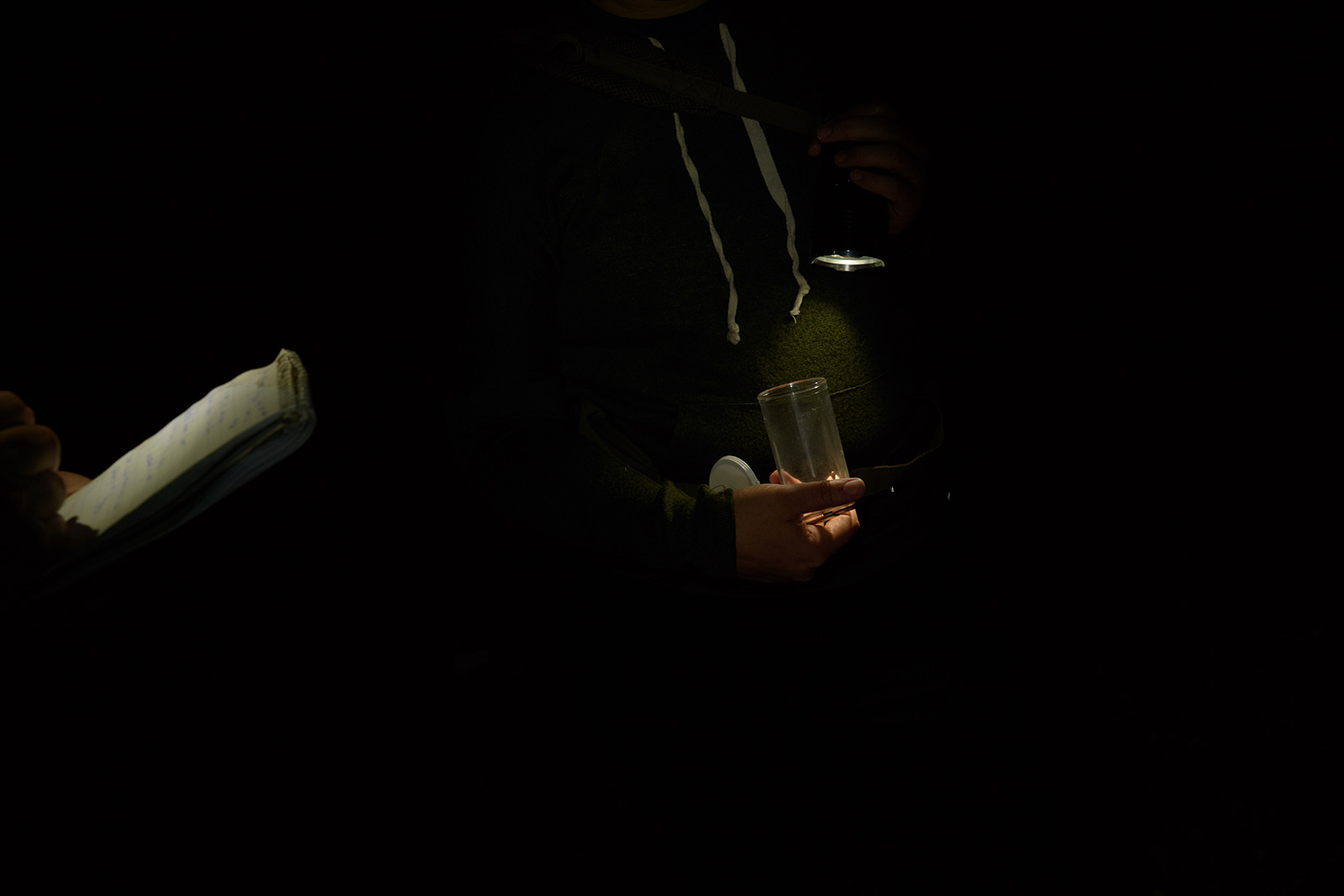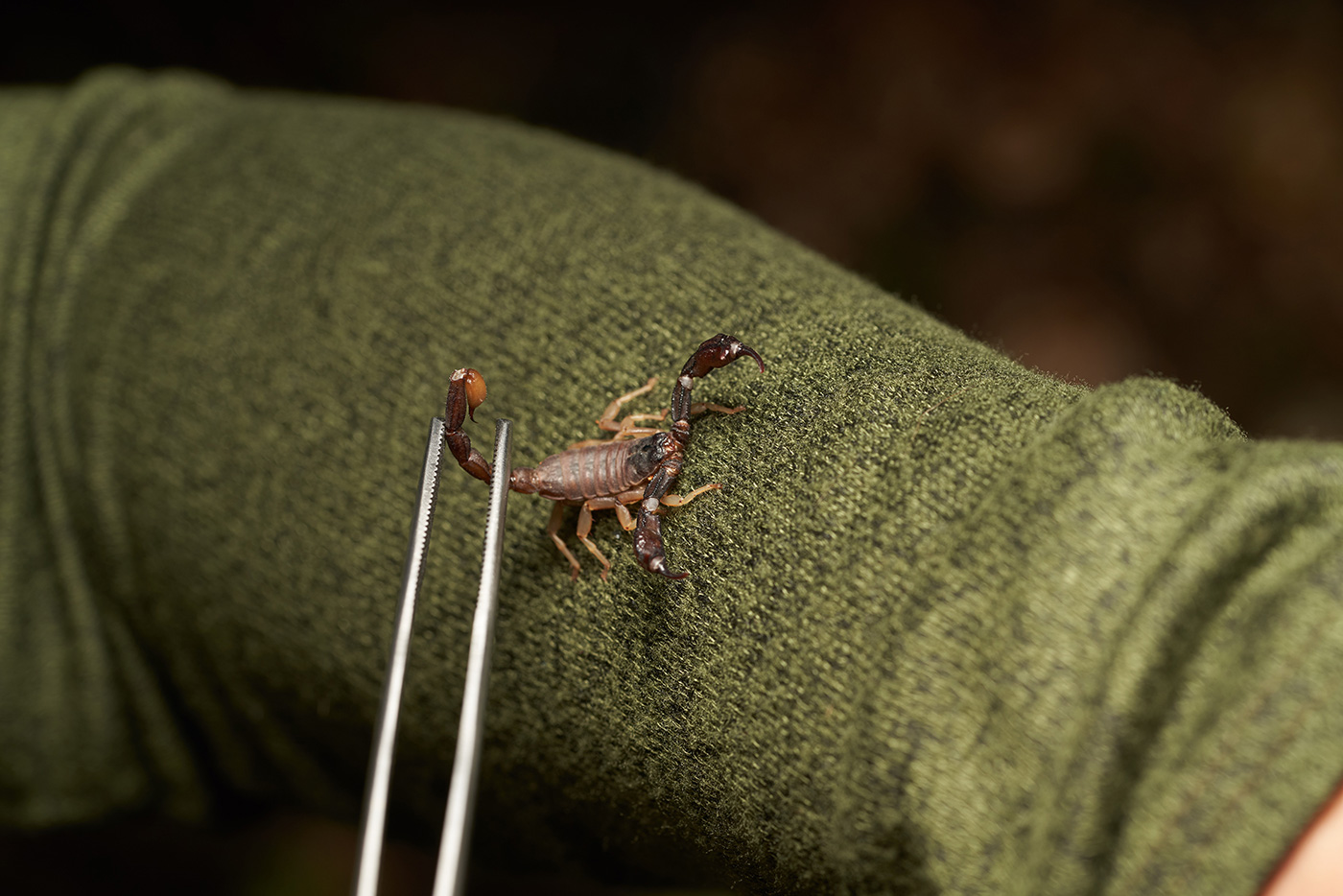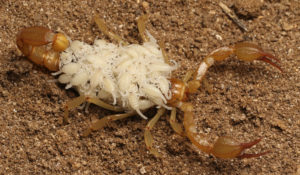Imagine a scorpion. Eight legs, two claws in front of its mouthparts, a venomous stinger dangling from a curved segmented tail, its carapace glossy—the scorpion moves silently and yet seems to promise that at any moment it could suddenly commence with a dreadful and irresistible chittering. It’s in a desert, maybe. Perhaps the scorpion is thinking about hiding in your boot or giving a frog an Aesopian death. Now imagine how many scorpions are loose in the world.
There are more. So many more.
We’ve described maybe 2,400 species of scorpions (only around 1 percent of which are dangerous to humans) and there are hundreds more scorpions that we haven’t yet named. Do you live on a continent? Is that continent Antarctica? No? Then there are scorpions on your continent. Are you in a swamp, a jungle, or the woods? A 100-foot-deep cave? In the Alps or the Andes? There are scorpions.
All of this is great news for Lauren Esposito, scorpion biologist and an assistant curator of the California Academy of Sciences, where she holds the Schlinger Chair of Arachnology. And on a moonless night in late September, she took us on an easy hike up Mount Tam, where there are—who knew?—a bunch of scorpions.

The scorpion we’re looking for has a classic sinister scorpion look: black-brown, with oversize boxing glove pincers. It’s called, depending on whom you ask, either the western forest scorpion or the Pacific forest scorpion and so is probably best identified by its proper Latin name: Uroctonus mordax, which is so delightfully metal that it sounds like a scorpion that eats elves for breakfast and hobbits for brunch. And surely it would, too, if it weren’t an arachnid smaller than your pinkie finger, with a sting milder than a honeybee’s, and so shy it generally only leaves its burrow to hunt on inky nights and even then is most often seen running away.
We saw maybe a half dozen U. mordax under Esposito’s black light. Most were just a pair of neon claws backing down into their burrows. One, Esposito caught with a pair of chopstick-length tweezers and placed on her sleeve, where it wandered harmlessly, as she said she’d never been stung while collecting. She said U. mordax can live for around 10 years, “to hazard a guess.”
To glimpse a scorpion in the wild, here are a couple of tips:
• Sometimes scorpions don’t become active until 30 to 60 minutes after sunset.
• Plan to bring a flashlight and a blacklight.
• Look for scorpions along trails where soil is broken up and roots stick out. Scorpions hide in these little crevices during the day, waiting at the entrances as they ready for night. Scorpions also hide in leaf litter along trails.
A guess?
“We don’t know the basic natural history of most scorpions,” Esposito said. “We don’t know how long they live, how many young they give birth to, or how they mate.”
What we do know is that in general and unusually for arachnids, scorpions give birth to live young and that the young—called scorplings—ride around on their mother’s back until at least their first molt. Scorpion mating, as it has been observed so far, is charming and dignified. Scorpions dance, claw-in-claw, moving from side to side, while rubbing their mouthparts together. Eventually, Esposito says, “he’ll put a sperm packet on the ground and she’ll pick it up—if his dancing was good enough. If not, maybe she’ll just eat it for the calories.”
“Cryptic” is the word Esposito most often uses to describe scorpions. Scorpions are the oldest predator on land. They are almost twice as old as the first dinosaurs, and as Esposito says, “450 million years is a long time for a lot of crazy stuff to happen.” For all their sinister reputation, most species of scorpions aren’t well documented—few great Victorian hunters ever traveled the globe looking for scorpions to mount on the walls of Bludleigh Court. Also a mystery is how scorpions find their way back home after a moonless night on the town. It’s been suggested, Esposito says, that some species of scorpions have eyes on top of their heads, pointing up, to triangulate their position and navigate by the stars. No one really knows, though, she says. They could just be looking out for predators.
“Scorpions have this intrigue factor where you see them and you’re scared,” Esposito says, “but you just want to get a little bit closer and have a look.”

As a kid in El Paso, Texas, Esposito was always looking under the pavers in her backyard to discover insects and bring them inside. Until, finally, her mom had had enough. “My mom taught me how to make a killing jar so that instead of bringing live cockroaches into the house, I’d at least be bringing in dead cockroaches.”
Her mom was trained as a wildlife biologist specializing in waterfowl. Her dad was a veterinarian, with a passion for racing pigeons. Esposito’s grandparents had a place in the Bahamas that she would visit as a child and she had to find her entertainment outside. “Every day, I’d fill up a bucket with baby hermit crabs and every night my parents would take them out, back into the ocean.”
When she went to college at the University of Texas at El Paso, she was pre-med, until her junior year, when she took classes in field biology and entomology. “The project was to go to the beach and count the number of left-handed vs. the number of right-handed fiddler crabs. And that dumb project convinced me that I never wanted to do anything but field biology.”
Scorpions, Esposito says, are fascinating to study because they are one of evolution’s great success stories. They have survived many millions of years and through such catastrophes as that which ended the age of the dinosaurs and the earlier Permian-Triassic event, or as it’s more colloquially known, “the Great Dying.” And through it all, scorpions as a group have experienced no major changes. A few times, in different species and in different ways, evolution has given them the ability to make sounds. And then there is their venom. Scorpions’ venom is highly specialized by their species, and can vary by whether a scorpion is trying to eat or not be eaten. A predator is liable to get blasted with a full dose of painful venom.
But if the scorpion is stinging its prey, it might use what Esposito calls a mostly enzymatic “pre-venom”; that is to say, the scorpion is getting a head start on digesting its food. A scorpion eats remarkably like a human toddler—as much as possible, it chews outside its mouth. Claws both immobilize prey and feed into, well, not scorpions’ mouths, but rather their mouthparts, which include another smaller set of pincers, the chelicerae. Those little pincers are like the little mouth inside the alien’s mouth in the Alien movies, only the chelicerae are tiny hands for further tearing apart food or breaking it apart against what you could call the scorpion’s face—although face is an unhelpfully anthropomorphic term for a lipless, noseless creature that keeps most of its eyes elsewhere.
At the same time, the scorpion coats its meal with digestive juices. Eventually, it slurps the softened bits into its food-hole: the pre-oral cavity. Here, the whole meal predigests some more, very slowly. As the meal dissolves, a nutritious slurry is swallowed into the digestive tract (it will exit through an orifice in the tail, near the stinger) and, hours later, like a two-year-old who has finally separated a cherry tomato from its peel, the scorpion spits out an indigestible wad.
It’s a rule of thumb that the thinner a scorpion’s claws, the more dangerous the scorpion. This is helpful, but not strictly accurate. It’s more accurate to say that the thinner a scorpion’s claws, the more likely it is to kill its prey by venom. A scorpion with fat claws uses them to crush its prey, and thus the scorpion will probably have a thin tail and stinger. Meanwhile, a scorpion with a big, fat tail and stinger is more likely to kill or paralyze its prey with venom.
What’s the difference between a venom-favoring scorpion and a dangerously venomous scorpion? It’s true that species that can harm healthy humans—such as the Durango bark scorpion, the Indian red scorpion, and the it-deserves-its-metal-name deathstalker —all have thin pincers and tails that are exaggerated in length or width. But then so does our very own sawfinger scorpion, which is about as dangerous to humans as a very shy and sedentary bumblebee that’s nocturnal but also scared of the moon. No doubt its venom is dangerous to small insects, though. Scorpion venom can be very particular in what species it affects.
Each scorpion species creates what Esposito calls its own “venom cocktail.” This mix uses a variety of enzymes and neurotoxins, some of which can be highly specific in how they affect the nervous system of their targets. Mostly, they interrupt the normal functioning of nerves, either by blocking nerves from signaling or causing them to signal wildly. Common effects are numbness, pain, and either the acceleration or cessation of heartbeat and respiration. Understanding how these and other compounds in venom cocktails work could be medically useful.
If you are to study scorpions and their venom in all their ancient variety, however, you must travel all over the world to do so, an activity that takes up about a third of Esposito’s working life. Esposito’s collecting expeditions have taken her to the Caribbean (her sentimental favorite), Central and South America, Africa, Asia, and an assortment of islands, including, most recently, Penang Island in Malaysia. California itself is pretty great, she says, having maybe the greatest beta diversity in the world, meaning it has scorpions that are from many different evolutionary lineages, although the best chance for finding a new scorpion species is in the tropics.
And what’s a typical night of collecting specimens like?
“I just walk really slowly with a black light and fall a lot,” Esposito says. She used to collect alone but now she brings someone along for safety. “People often ask if I get scared when I’m out collecting. Yeah, sure,” Esposito says. What’s scary? “People, definitely. Stray dogs barking, for sure, because, in the tropics, dogs don’t necessarily have owners and leashes.”

There are other hazards of collecting by black light, particularly if other people have been in the area, because toilet paper glows under ultraviolet light. And rats are easily found, because they micturate all over themselves and the uric acid crystals light up yellow. “Rats are disgustingly fluorescent,” Esposito says. And then, most loathsome of all, there is the empty plastic Sprite bottle, which reflects the exact same shade of green as a scorpion. It’s a neon green, she says, “like the toxic slime that splashes on the villian and gives them powers.”
I suggest that if that happened to her, with her Ph.D. she could become the nefarious Dr. Scorpion.
There’s a thoughtful pause.
“Dr. Scorpion? I think that would be better than the Scorpion Queen,” she says, “which is the moniker I usually get, like I’m The Rock or something.”
Of course, super villainy is—as super villains are always pointing out in comic books—a matter of perspective. One person’s cheerful good science is another arachnid’s inescapable killing jar. Earlier in the hike, Esposito had spotted the claws of a U. mordax as it backed down its hole, and she said that a good way to catch scorpions is to grab a live moth and turn it loose as bait right outside a burrow entrance. Later, watching another mordax disappear into a hole in a cliff face, she said, “If I was really collecting for species discovery, I’d rock-hammer it out of there.”
Esposito estimates that she’s collected a couple dozen new species of scorpions, although so far only a handful have been studied and described. Discovering a new species is more complicated than plopping an unfamiliar scorpion in your killing jar. For starters, you might not even realize you’ve found something new until after you’ve returned to your office and enjoyed the benefits of good magnification, access to the scientific literature, caffeine, and possibly some genetic sequencing. Even then, you can’t say much until you’ve collected multiple members of the same species, including at least one male and one female, which isn’t the easiest thing to do when you’re talking about creatures that like dark nights and dislike each other.
As many specimens as Esposito has collected—and she thinks she’s collected over 1,000—the number is small compared to the 14 to 20 million specimens in the California Academy of Sciences’ entomology collection. She sees herself as a steward of this record of life on earth, identifying species in space and time. It’s a record that may be examined in the future in ways we can’t yet imagine, just as its first collectors in the 19th Century couldn’t have imagined the DNA testing Esposito uses, often to flesh out her own research on arachnid evolution.
Near the end of the night, Esposito mentions that when she was in middle school, she had to write a paper about what she wanted to be when she grew up. “I wrote that I wanted to be a hobo or a rocket scientist. And I feel like I ended up just in between those two.”





